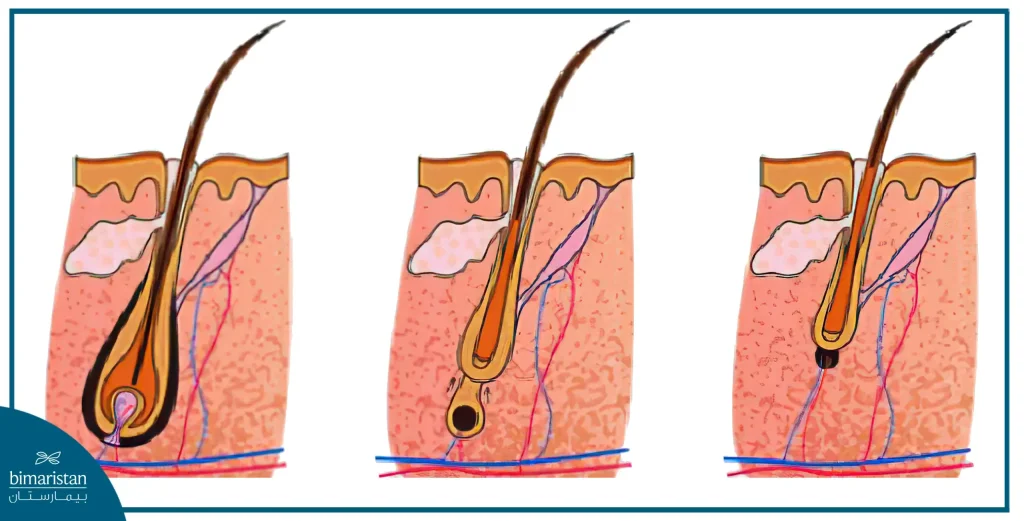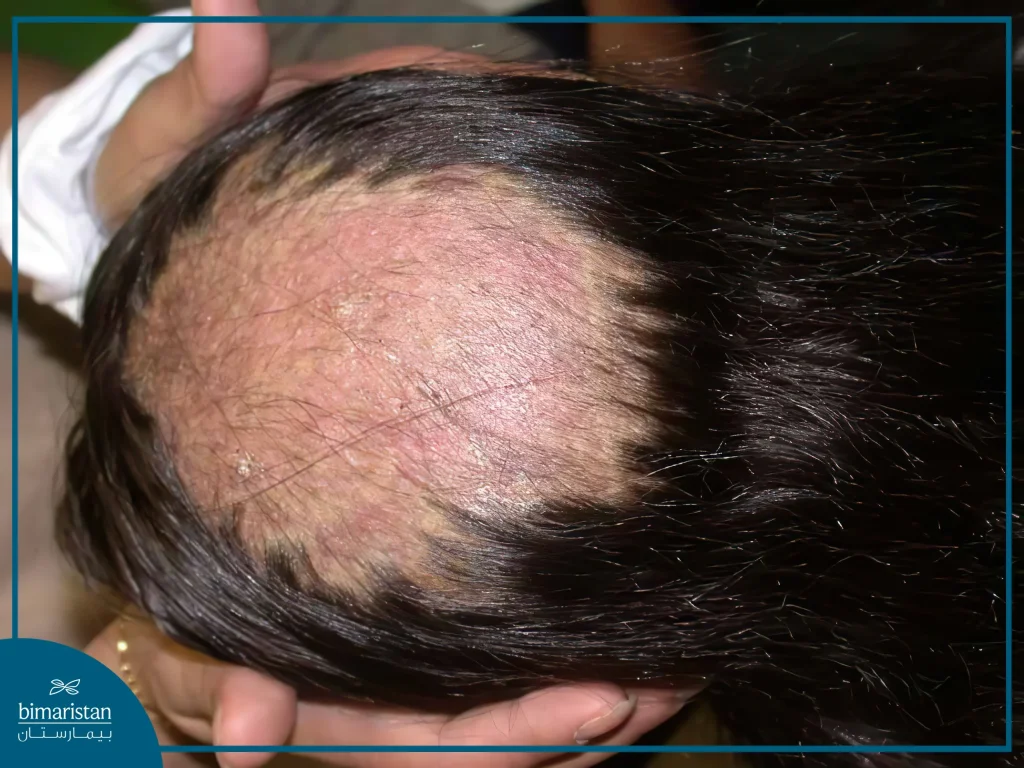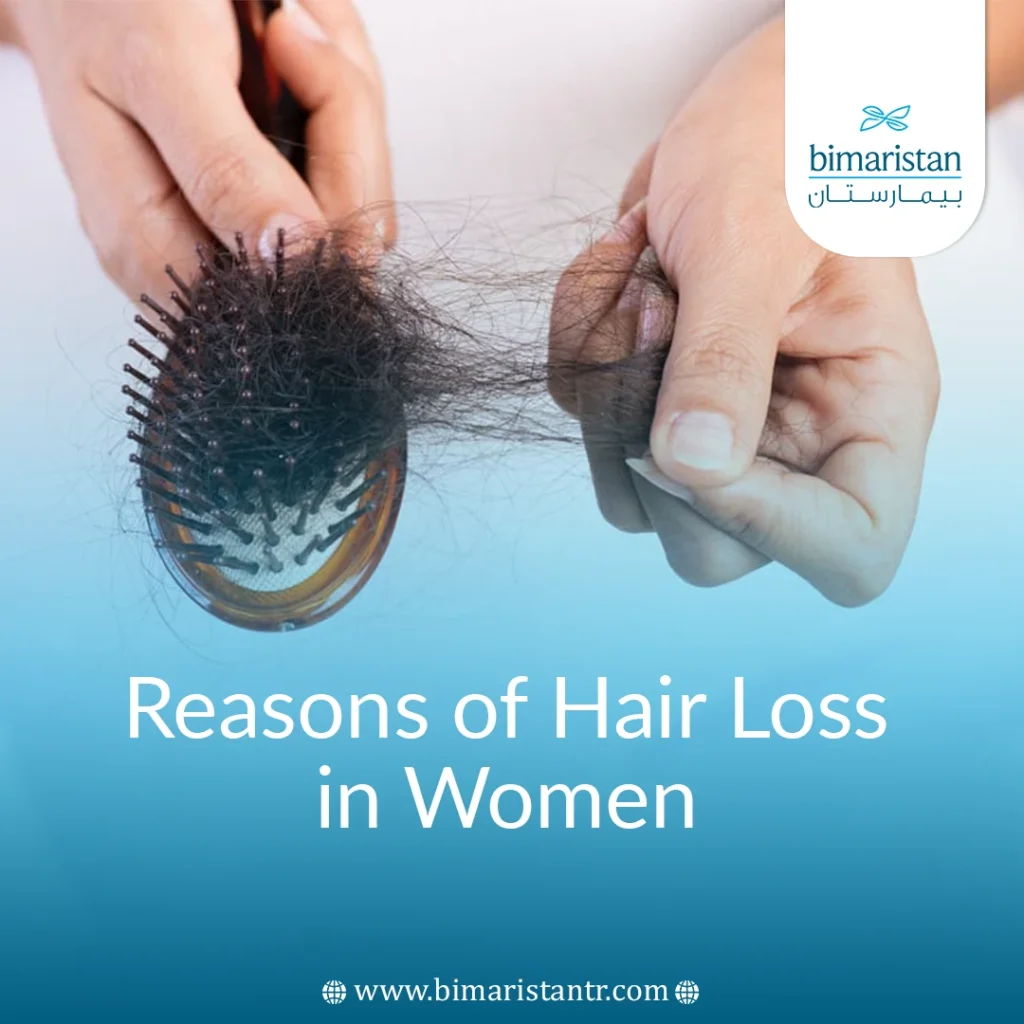The reasons for hair loss in women are diverse. Identifying the cause is key for effective treatment and restoring natural hair.
Hair is considered one of the basics of beauty in women, so hair loss is one of the most important problems women face daily. Due to the importance of hair in their daily lives, it causes emotional disturbances and problems with confidence in patients.
Reasons for hair loss in women
Hair loss is one of the most common problems women suffer from worldwide, and knowing the cause of this loss is not easy due to the variety of diseases and problems that cause it; in this article, we will learn about some of the most common causes.
But before learning about the reasons for hair loss in women, we must know the stages hair goes through before falling out.
Hair life cycle
A hair follicle goes through three life stages: formation, falling out of the body, and a new follicle starting to grow in its place.
- The first stage is the hair growth stage, which usually lasts between 2 and 8 years. During this stage, the hair grows and lengthens until it ends.
- The second stage is the regression period, which lasts between 2 and 3 weeks. The existing hair follicle recedes during this period, and a transitional follicle grows before falling out.
- The third stage is the resting stage, which lasts from 2 to 3 months and ends with the hair falling out and being replaced by a new follicle.

Medical history and clinical examination to limit the reasons for hair loss in women
When you go to the doctor, he will ask you some questions to diagnose the cause of hair loss. The doctor may ask when the hair loss started and whether it was gradual or sudden because each type has different causes.
He may ask about the place where the hair falls out the most because it may indicate a specific skin disease or another cause. Then, the patient will undergo hair examinations, including the traction test.
Tension test
The doctor places approximately 50 hairs between his fingers, pulls them lightly, and looks to see how many hairs are in his hand. In the standard case, the doctor’s hand comes out about three to five hairs that are in the resting phase. Still, in the case of a patient with excessive hair loss, such as telogen effluvium or alopecia areata, the doctor will easily pull more than six hairs.
The patient will then request laboratory tests to confirm his diagnosis, which are usually limited to blood tests or a scalp biopsy.
Sudden hair loss
There are several reasons for sudden hair loss, and we will now mention some of the prevalent reasons that may be the cause of sudden hair loss:
Telogen hair loss
Telogen hair loss occurs due to disturbances in the hair growth cycle, as many hair follicles enter the resting phase together, which leads to excessive hair loss. Among the causes of telogen hair loss are:
Stress and psychological pressure
Stress is one of the most common causes of hair loss in women. It may lead to telogen hair loss, which appears after about three months of continuous psychological pressure.
Malnutrition
Like all other body organs, hair needs proper nutrition to grow, so malnutrition leads to hair loss. For example, an intense diet to lose weight will lead to hair loss, so it is preferable to ask the doctor about the diet that should be followed when going on any diet.
Excess vitamin A in the body leads to hair loss, and a severe deficiency in vitamin D will also lead to hair loss. These conditions are treated with nutritional supplements.
Pregnancy
Pregnancy is one of the reasons for hair loss in women due to hormonal changes and stress that affect pregnant women, so hair loss during pregnancy is a common problem, and hair usually returns to normal after childbirth.
Childbirth
Hair loss may occur 3 to 6 months after childbirth, and this may be attributed to hormonal changes or to stress and lack of sleep that the infant may experience in the first years of his life.
Alopecia
Several types of alopecia differ in their management and treatment methods, and the reason for their occurrence. However, they are all characterized by sudden hair loss that may follow a specific distribution or form an empty area in the body.

Involuntary Alopecia
As we age, more hair follicles enter the resting phase, which leads to hair loss. The remaining hairs become shorter and fewer in number.
Androgenic Alopecia
One of the most important reasons for hair loss in women is androgenic alopecia, which is almost a genetic condition caused by increased levels of male androgen hormones in the body. This causes what is called male-pattern baldness in men and female-pattern baldness in women.
Female-pattern baldness usually does not appear until age forty and is characterized by a general thinning of the entire scalp with increased hair loss in the crown area.
In this case, the hormone dihydrotestosterone is responsible for hair loss in women, which is called female-pattern baldness.

Alopecia areata
Alopecia areata is an immune disorder in which the body attacks the hair follicles, causing patchy hair loss and may lead to complete baldness (alopecia totalis). Still, in about 90% of people, this condition disappears within a few years without knowing the cause.
Scalp Ringworm
Tinea is a fungal disease that can affect any body area, leading to hair loss in the infected area. The predisposing factors for fungal infections include:
- Heat and humidity.
- Excessive sweating and sebum secretion.
- Age, gender, and race.
- Obesity.
- Immunosuppression and related causes, such as diabetes, AIDS, and certain medications.
Fungal infections can manifest in several forms, including:
- Pityriasis Versicolor: Rare in children but common after puberty. It is asymptomatic and tends to worsen during summer, diagnosed clinically by its mild, flaky appearance.
- Tinea Favosa (Scaly Ringworm): This type is spread through direct or indirect contact. It often appears as hair breakage or shedding outside the skin while the hair follicles remain intact. It is commonly seen in school-age children and rarely affects adults.
- Suppurative Tinea (Pustular Ringworm): Spread through direct contact, leading to pus-filled lesions on an inflamed, red base caused by the infection. It may also be associated with enlarged lymph nodes or allergic reactions to the fungus. The majority of cases are seen in children.
- Tinea Capitis (Crusted Ringworm): Typically starts in childhood and may persist into adulthood if untreated.
- Additionally, there are many other forms of tinea, including tinea of the chin, face, body, nails, etc.
Causes of chronic hair loss in women
Chronic hair loss is more common than sudden hair loss due to various diseases leading to hair weakness and eventual loss. These causes include:
Anemia
Anemia causes hair loss due to insufficient oxygen transport to the hair follicles. Poor nutrition also weakens the follicles, which in turn weakens them and causes their loss.
Thyroid Diseases
Hypothyroidism and hyperthyroidism are both causes of hair loss in women. Thyroid hormones regulate many metabolic and anabolic processes in the human body, including the hair growth cycle. Any imbalance in thyroid hormone levels affects the body’s overall structure, not just the hair’s composition and growth. These hormonal changes can result in weight fluctuations (either gain or loss) and heat sensitivity issues, which may also be associated.
Diabetes
Some studies link hair loss to diabetes due to blood disorders that occur in diabetes, which lead to poor hair nutrition, and women are often more susceptible to hair loss due to diabetes than men.
Polycystic Ovary Syndrome (PCOS)
PCOS is usually caused by an overproduction of androgens in the adrenal glands, ovaries, pituitary, and adipose tissue. Androgens play a key role in the development of male characteristics. Though they are present at lower levels in women, they contribute to various physiological processes, including their psychological effects. Changes in androgen levels, whether increased or decreased, can lead to specific physical and psychological disturbances. In PCOS, elevated androgen levels lead to changes in fat distribution, which adopts a male-pattern distribution. Common clinical manifestations include acne, hirsutism (excessive hair growth in male-pattern places of the body), infertility, and menstrual irregularities. Additionally, the impact of androgens on hair results in the shrinkage of hair follicles, causing thinning, weakened hair, and cessation of growth, which results in hair becoming finer and less dense.
Tips for fine hair
- Using hair thickening products
- Using shampoo and conditioner in every shower
- Finding a suitable hairstyle for fine hair and not using hairstyles that cause tension on the hair, because they lead to hair loss
- Do not comb wet hair
- Reducing the use of electric dryers on hair
- Some foods are beneficial for hair loss:
- Nuts are one of the best foods for hair because they contain zinc and proteins necessary for hair growth and reproduction
- Meat and milk
- Legumes
- Sweet potatoes and spinach
- Sour foods that contain a lot of vitamin C
Hair loss treatment in women
Hair treatment for hair loss depends on knowing the reasons for it. Here, we will briefly mention some available treatments, considering that diseases that cause secondary hair loss are sufficient to treat the primary disease and prevent hair loss.
- Minoxidil: A drug available as a spray, cream, or shampoo for hair loss in women, which leads to the expansion of the vessels in the scalp and increases the nutrition coming to the hair follicle, leading to hair regrowth.
- Finasteride: This medication reduces the male androgen hormones in the human body, which helps alleviate androgenic alopecia in women.
- Corticosteroids (cortisone): Medications similar in composition to the corticosteroids in the human body, which reduce immunity and help treat hair loss caused by autoimmunity.
- Antibiotic ointments help fight skin bacterial infections that cause hair loss.
- Plasma injections into the scalp are a newly used method to stop hair loss, but they are not a treatment for a specific cause of hair loss in women.
- Systemic or topical antifungals (such as shampoos) are used to treat fungal infections.
- Pharmacological treatment, such as oral contraceptives and ovulation stimulants, is indicated in the case of polycystic ovary syndrome (PCOS). Surgery may be considered in refractory cases.
- Thyroid disorders may be treated with medications or surgery.
- Female hair transplant: hair implants for women have many methods that aim to extract hair from a specific part of the body and transfer it to the place of hair loss.
Read more about: Hair Transplant in Turkey.
The reasons for hair loss in women vary and cannot be limited to one specialty. Hair loss is a common problem facing women and young women because of its harmful psychological effects on them. Hair loss can also be classified into two major sections: sudden and chronic hair loss, which include many other causes. Due to the many reasons for hair loss in women, it is preferable to go to the doctor when facing the problem of hair loss so that they can make the appropriate diagnosis and start the proper treatment. He may also provide some advice for taking care of the hair and starting a diet that may help reduce hair loss.
References:
- Hair Loss: Common Causes and Treatment.
- Diffuse hair loss: Its triggers and management.
- An Approach to Hair Loss in Women.
